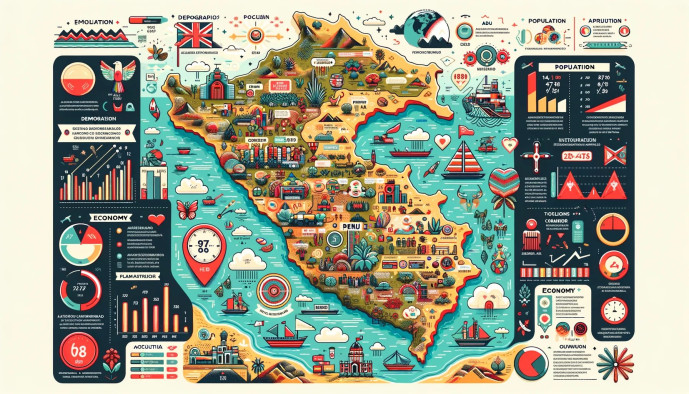Key Facts of Peru: Demogragphy, Population, Economy, Politics, etc…
Explore Peru's essence: vibrant demographics, economic dynamics, and political landscape.

Geography & Climate
Location & Borders
Peru is situated in Western South America, with a strategic location on the Pacific coast that has shaped its history and trade. It shares borders with Ecuador and Colombia to the north, Brazil to the east, Bolivia to the southeast, and Chile to the south.
Key Geographic Regions
Your journey will take you through some of the most varied landscapes on the planet, often in a single day. This dramatic environmental shift is a core part of the Peruvian travel experience.
- The Coast (La Costa): A narrow band of arid plains and deserts lining the Pacific Ocean. This region is home to Lima, the nation’s capital, and other significant pre-Columbian archaeological sites.
- The Highlands (La Sierra): The majestic Andean mountain range that forms the country’s spine. This is the heartland of the Inca Empire, where you will find Cusco, Machu Picchu, and the high-altitude expanse of Lake Titicaca.
- The Jungle (La Selva): Encompassing the vast Amazon Rainforest, this region covers approximately 60% of Peru’s territory. It is a world of immense rivers, dense vegetation, and unparalleled biodiversity.
Biodiversity
Peru is recognized as one of the world’s most megadiverse countries. Its three distinct geographic zones create a vast number of unique ecosystems, supporting an incredible array of flora and fauna, from the Andean condor to the Amazonian jaguar.
Population & Demographics
Population Size
With a population of around 34 million people, Peru is the third most populous country in South America, following Brazil and Colombia.
Ethnic Composition
The nation’s identity is a rich tapestry woven from diverse ancestries. The largest group is Mestizo, of mixed Amerindian and European heritage. A significant portion of the population is Amerindian, including proud indigenous peoples such as the Quechua and Aymara. The cultural landscape is further enriched by descendants of European, Afro-Peruvian, and Asian-Peruvian immigrants.
Official Languages
Peru has three official languages, reflecting its multicultural heritage.
- Spanish: The most widely spoken language, used in government, media, and commerce throughout the country.
- Quechua: The ancient language of the Inca Empire, spoken primarily by communities in the Andean highlands.
- Aymara: Spoken in the southern highlands, particularly in the regions surrounding Lake Titicaca.
While Spanish is dominant and sufficient for travel in most areas, you will find that in more remote highland communities, Quechua is often the primary language. A few words in Quechua, such as ‘Allinllachu’ (hello), are always warmly received.
Economy
Currency
The official currency is the Peruvian Sol (PEN), and its symbol is S/. While the Sol is the standard for daily transactions, US Dollars are often accepted in major hotels, tour agencies, and upscale restaurants for larger purchases. For markets, taxis, and smaller local establishments, it is highly recommended to use Soles.
Key Industries
Peru’s economy is diverse and dynamic, driven by several key sectors.
- Mining: The country is a leading global producer of copper, gold, silver, and zinc, making mining a major pillar of its economy.
- Agriculture & Fishing: Peru’s varied climates allow it to be a key exporter of products like avocados, grapes, asparagus, and quinoa. Its rich coastal waters make it a world leader in anchovy fishing.
- Tourism: A vital and growing sector that provides significant income and employment, particularly in regions like Cusco, Arequipa, and the Amazon.
- Textiles: Renowned for its luxurious textiles, especially high-quality products made from alpaca and the prized vicuña wool.
Economic Context
Peru is classified as an upper-middle-income, emerging market economy. It is important for travelers to be aware of the economic disparity that exists between the more developed urban coastal areas, like Lima, and the more traditional, rural regions of the highlands and jungle.
Politics & Government
System of Government
Peru is a constitutional Presidential Republic. The government is structured into three independent branches: the Executive, headed by the President; the unicameral Legislative branch (Congress); and the Judicial branch. The capital city and seat of government is Lima.
Administrative Divisions
For administrative purposes, the country is divided into 25 regions, in addition to the constitutional province of Lima. This structure allows for regional governance to address the diverse needs of the country’s distinct geographic zones.
Political Stability Note
Peru has, at times, experienced periods of political volatility. However, it is important to note that these events are typically concentrated in the capital and rarely affect tourist operations in key areas such as Cusco, the Sacred Valley, or the Amazon. We advise you to remain aware of current events through reliable news sources, but this should not be a cause for undue concern regarding your itinerary.
Religion
Dominant Religion
The predominant religion in Peru is Roman Catholicism, a direct legacy of Spanish colonization. You will see its influence in the magnificent cathedrals, churches, and religious art found in every city. However, what makes Peru’s spiritual landscape so fascinating is the syncretism, or blending, of Catholic doctrine with pre-Columbian, indigenous beliefs and traditions. This is particularly visible in the Andes, where rituals honoring Pachamama (Mother Earth) coexist with Christian holidays, creating unique and vibrant local festivals and ceremonies that are a highlight for many visitors.
Could not load FAQs. Please try again later.